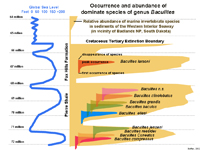2.22: The Cretaceous-Tertiary Boundary (or K/T Boundary) Extinction
- Page ID
- 9791
The Cretaceous-Tertiary Boundary (or K/T Boundary) Extinction
The Cretaceous-Tertiary boundary is associated with one of the most investigated mass extinction events. The age of the K/T boundary is currently estimated to be about 66 million years based on absolute dating methods. It is has been well investigated partly because it is the youngest of the large extinctions that totally changed the nature of life on Earth. It is also well exposed in many locations on land around the world and has been studied extensively in core samples from deep-sea drilling projects.
The K/T extinction event is believe to have been caused by a massive asteroid impact in the Yucatan region of Mexico, although other possible sites of large impacts are being considered. What is known is that all species of dinosaurs on land, and marine reptiles and ammonites in the marine realm vanished.
The massive asteroid impact and following shock waves, monstrous tsunamis, firestorms, ash clouds, toxic gas clouds, and global winter-like condition that followed caused ecosystem collapse and failure of the food chains and webs in both the oceans and on land.
It is important to note that all species that exist today are descendant of the limited number of species that survived the global catastrophe... small mammals, birds, invertebrates, reptiles, amphibians, fish and other surviving groups had evolutionary advantages that allowed them to survive. With the dinosaurs, pterosaurs, large swimming reptiles and other large animals of the Cretaceous Period out of the way, the surviving species proliferated and moved into empty and new niches that allowed them to prosper and diversify.
The K-T boundary occurred near the end of the Zuni Sequence Cycle when sea level also fell around the globe (see Figure 2.13). In the following Cenozoic Era many changes continued to occur including the uplift of the Rocky Mountain region and the withdrawal and disappearance of shallow inland seas and great lakes that previously flooded the Western Interior region.





